Mechanical Properties and Adhesion of Several Powder Coatings
Most powder coatings have superior adhesion and mechanical properties compared with air-dried or baked waterborne and solution coatings. With the exception of those containing acrylic or silicone resins, powder coatings exhibit high impact resistance, direct and reverse, good flexibility and excellent adhesion as measured by the cross-hatch tape pull test. Attempts to determine a more quantitative measure of adhesion by a tensile pull-out test are usually unsuccessful with powder coatings because the adhesion of the coating to the substrate is greater than the adhesion of the probe to the coating. Therefore, tests other than those normally used need to be developed to discriminate between the adhesion and mechanical properties of powder coatings.
This paper reports on adhesion and related properties for three generic types of powder coatings at two variations in pigment-to-binder ratio (P/B), based on test equipment used in other industries for characterizing the adhesion of thin films to substrates. Test results are reported for the force required to separate the coating from the substrate using a computer-controlled knife edge using the Hesiometer and the force required for a spherical diamond stylus to progressively penetrate the coating and subsequently remove it from the substrate, utilizing the Stylometer.
Background
The relationship between the dynamic mechanical properties of coatings and physical properties, such as hardness, flexibility, mar resistance and others, has been studied and is generally well known (1). However the role of adhesion in influencing the properties of the coating on a substrate is less well known. Adhesion is not a fundamental property of a material, and measures of adhesion are rather subjective and a function of the test method used to make the measurements. However, most coating chemists will agree that a coating with "good" adhesion to the substrate will have superior mechanical properties and corrosion resistance and will outperform a coating with "poor" adhesion. Adhesion is usually measured by the cross-cut tape test (2) method B and sometimes by the tensile pull-off method (3).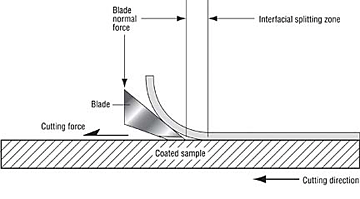

The Experiment
A series of nine powder formulations was prepared for this study: three formulations each in polyester/TGIC, polyester/urethane and epoxy/polyester binders. The three formulations consisted of:- a low pigment/binder (P/B) ratio (PVC = 4.45)
- a typical level of 60 parts per hundred parts of binder resins (PHR), pigment and filler, (PVC = 14.21), with barium sulfate as a filler
- the same PVC as the second formulation, but using calcium metasilicate as gloss-reducing filler.
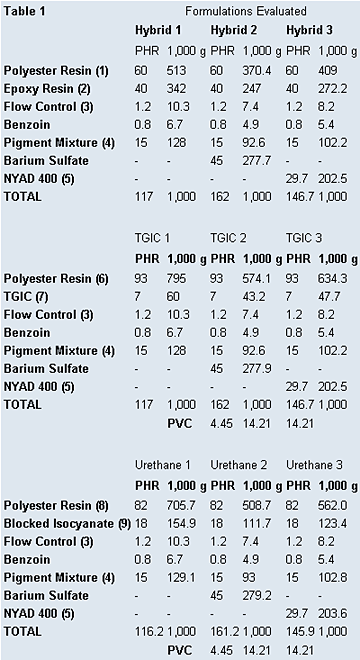
(1) Acid No. = 40
(2) Epoxide Equivalent Weight = 750
(3) Acrylic Type, 67% active on silica
(4) Pigment % Titanium Dioxide 9.00 Carbon Black 6.87 Yellow Iron Oxide 48.33 Ni/Sb/TiO2 35.80 TOTAL 100
(5) Caldium Metasilicate (6) Acid No. = 33
(7) Triglycidyl Isocyanurate
(8) Hydroxyl No. = 40
(9) Caprolactam-blocked IPDI Trimer
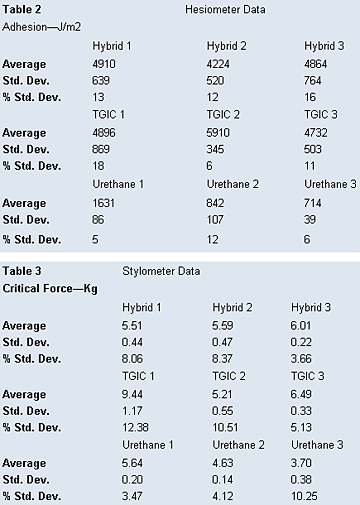
There are two levels of interest in using the Hesiometer: practical adhesion measurement and scientific studies of adhesion. This instrument has effective application to both, although this experiment only used the practical adhesion capability.
There are two different methods for addressing the blade to the sample:
- Cutting through the upper layers and to the interface of interest. This is employed in the practical adhesion method.
- Starting on an uncoated portion of the substrate surface and advancing toward the coating edge. This is used for scientific applications where the coating is shaped in a distinct pattern to eliminate blade edge spurious energy consumption.
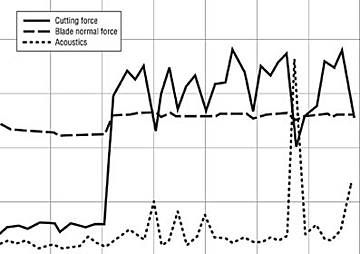
Output of the Hesiometer consists of a plot of the cutting force, net normal force and acoustic output. As the blade cuts through the coating, the cutting force increases. When the blade contacts the substrate, an elastic "rigid beam" segment of the coating projects a crack forward of the blade tip with a simultaneous abrupt decrease in the cutting and net normal forces. Initiation of interfacial cracking is signaled by an abrupt increase in acoustic output. The crack propagation manifests itself as a cyclical buildup and reduction of both cutting and normal forces. Major bursts of acoustic energy are associated with the incremental advance of the crack. Figure 3 shows the Hesiometer plot typical of the formulations studied.
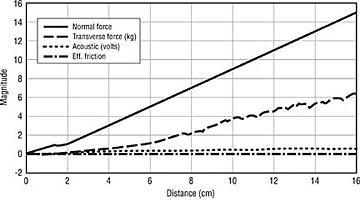
The primary use of the Stylometer is in the measurement of relative adherence of thin films, particularly for the evaluation of ultra-adherent coatings, such as diamond, nitride or other forms of tribological or wear coatings. In these cases, there is virtually no other method capable of measuring adherence in the required range, which is above 90 Mpa (>13,000 psi).

Test Results
The energy required to progressively separate the various powder coatings from the substrate using the Hesiometer are listed in Table 2. In the case of formulation 1 of each of the chemistries, (the lowest P/B ratio), the hybrid and TGIC-polyester formulations show a significantly higher value than the urethane. It should be noted, however, that the urethane formulation used in this study is at the lower end of the cross-link density range, based on a relatively low OH number polyester resin. The higher P/B ratio formulations appear to show no consistent pattern compared with the lower P/B control. In the hybrid formulation, there is a slight decrease in adhesion energy in the filled system, while with the urethane formulations there is a significant decrease. The TGIC-based formulations show a slight decrease with one filler and an increase with the other.Although the data for the samples did not show a fundamental trend, the method was able to reproducibly measure the practical adhesion energy of each sample. This practical adhesion energy measurement not only included the adhesion of the coating but also the adherend deformation energy and the frictional force between the blade and the coating. It appears a practical adhesion energy measurement could be useful in the day-to-day quality control of powder coated surfaces but may not provide a meaningful comparison of the relative adhesion of different coatings.
The Stylometer data for the various coatings is shown in Table 3. In the case of the control (low P/B ratio) coatings, the TGIC formulation shows significantly higher values for the critical force than the hybrid and urethane formulations, which exhibit close to the same values. For the filled formulations, the hybrid shows a slight increase over the control, while the TGIC and urethane formulations show a decrease. Scratch adhesion measurements again do not seem to show a consistent trend for the coatings tested. Since the Stylometer is purely a qualitative adhesion tool, it appears to be best suited to testing the relative scratch resistance of powder coatings but not the quantitative differences between the coatings as initially hypothesized.
A typical Stylometer plot for formulation is shown in Figure 4, and a photograph of a tested panel is illustrated in Figure 5.
Conclusions
It is difficult to determine the significance of the Hesiometer and Stylometer test results generated in this study for various powder coatings. However, these tests may be valuable in research studies to elucidate the effect of formulation variable on certain physical properties, such as the effect of increasing cross link density on adhesion. Since the Hesiometer can separate two coating layers as well as a coating from a substrate, it may have utility in evaluating the adhesion of various topcoats to a powder primer, for example.It is possible that Hesiometer and Stylometer test results may also be useful as a quality-control tool to measure the consistency of properties for various lots of the same material over an extended period of time.
Looking for a reprint of this article?
From high-res PDFs to custom plaques, order your copy today!



